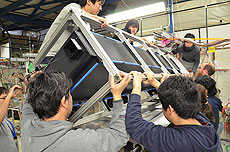Experiment at Fermilab's Test Beam Facility: Propagating photons
 |
|
The experiment T-1019 team carefully positions the detector for testing. Photo: Toru Iijima
|
Japan's high-energy physics laboratory, KEK, is one step closer to completing the SuperKEKB Project, which would increase the KEKB accelerator's target luminosity to 40 times greater than its current record. To help reach that goal, Fermilab's Test Beam Facility lent a hand.
The SuperKEKB Project broke ground in November of last year, with a plan for several upgrades to both the KEKB accelerator and the Belle detector. Every upgrade requires thorough testing, and experiment T-1019 was a crucial milestone for this stage. Tested at Fermilab, the research team used the high-energy beam to analyze a new detector concept, the imaging Time Of Propagation detector. SuperKEKB will use this detector to distinguish pions from kaons in the decay products of electron-positron collisions. Kaons contain strange quarks while pions do not. The ability to separate the two is essential for the physics program planned after the full Super B-factory upgrade.
"Evaluation of the full-size detector, finely segmented photodetector, and integrated readout electronics is a crucial step toward finalizing the specifications for the components of the Belle detector upgrade," said Gary Varner, the experiment T-1019 spokesperson and a professor at the University of Hawaii.
It's close to impossible to see the pions and kaons without the specially designed Belle II detector. Housed in the center of the detector are time-of-propagation counter arrays, which reflect and magnify the light given off by photons. Called Cherenkov photons, the particles create a ring of light as they decay, making for a more identifiable track. This allows researchers to examine the lifetimes of each particle closely.
To test how well the detector and all of the components are working, the collected data is compared to a Monte Carlo data set. A Monte Carlo simulation makes precise predictions for what the measurements of the experiment should be. If the actual measurements differ from these simulated predictions, researchers work to understand these differences and improve the modeling of the detector performance.
"We know the momentum, and we want to distinguish between the strange quarks," Varner said. "We can make that distinction by measuring the velocity, or time-of-flight of the particles."
Photons are produced inside a quartz radiator bar that is a hundred inches long. They travel down the bar and are detected by an array of Micro-Channel Plate photodetectors, which provides exquisite single-photon timing resolution. These MCP are on the other side of an expansion block glued to the end of two pieces of quartz radiator. End-to-end, the whole thing is about the size of a dining room tabletop. The quartz radiators are polished to a mirror finish, reflecting the photons and propagating the light to the end of the detector. The MCP, developed specifically for this application by Hamamatsu Photonics, turn the single photons into charged pulses that can be digitized and measured.
"This detector is a significant improvement over the composite system of Belle I," Varner said. "T-1019 provided an opportunity to quantify this improvement."
The journey for a single photon runs at tenths of a picosecond, which is a trillionth of a second. Belle I, the original detector, used a time-of-flight system to differentiate between pions and kaons.
"We've tested the electronics with a laser and on a bench, but this was the first time in the final configuration," said Kurtis Nishimura, a University of Hawaii postdoctoral fellow. He has spent over a year working on the electronics. "We need to make them work on this detector."
The data collected from this experiment will be compared to the Monte Carlo. The researchers hope that the actual data isn't too far from the Monte Carlo expectation, as that will provide evidence that the simulation is reliable. The Belle II detector, a project officially supported by the U.S. Department of Energy, should begin running at SuperKEKB in 2015.
"Complete analysis of this experiment won't be finished for a few months, because we have a very large and rich data set," Varner said. "Lessons learned will be essential to the final design choices for the detector configuration and component choices."
—Ashley WennersHerron
|